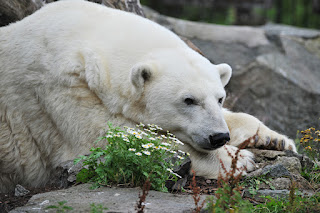The death of Knut, the world's most famous polar bear, has reopened the debate on the ethical minefield of man's relationship with wild animals. So should polar bears be kept in zoos, asks Tom de Castella.
Knut was born in Berlin Zoo in December 2006. Rejected by his mother, he was put in an incubator and brought up by humans.
His abandonment, cute looks and close relationship with the charismatic zookeeper Thomas Doerflein, turned him into a huge star. He became an environmental symbol, acting as a mascot for the German government's campaign against climate change and being superimposed into a photograph with Leonardo DiCaprio for Vanity Fair's Green Issue in May 2007.
But news of his premature death at the weekend has spurred on those who question both the way Knut was treated and the very fact polar bears are in zoos at all.
While polar bears can live to 30 years old, Knut was only four years and three months when he died. The cause of death has yet to be ascertained but already there have been accusations from animal rights groups.
From the word go, Knut's life was controversial. Shortly after his birth, the German media reported that an animal rights campaigner was calling for him to be put down rather than brought up by humans. It prompted a huge groundswell of sympathy for the bear, which never went away.
For Andrew Linzey, director of the Oxford Centre for Animal Ethics, it is a tragic tale from start to finish.
"Frankly, it would have been better for Knut not to have existed at all than live such a miserable life."
Those who questioned the implications of Knut's hand-rearing have suggested he suffered inevitable behavioural problems as a result both of his treatment and the crowds at the zoo.
But Linzey, author of Why Animal Suffering Matters, believes the issue is not whether the zoo was right to hand rear Knut. Once the cub was born, the management had a duty to hand rear him because a zoo is an artificial, "controlled environment".
The fundamental problem is wild animals being kept in captivity at all, he argues. "Zoos impose unnatural lives on most of their captives. People just see a cuddly bear and they want to gawk at him, but what they should see is an animal deprived of its natural life, exhibited for entertainment and profit."
And profit became a big part of Knut's short life. In 2007 alone Berlin Zoo made an estimated five million euros through increased ticket and merchandising sales. Hundreds of fluffy white toys were sold every day across the city, newspapers offered Knut figurines for 148 Euros and in 2008 a movie, Knut and His Friends, opened in cinemas across Germany.
Knut's life was about celebrity rather than natural history, says Ian Redmond, a consultant to the Born Free Foundation's polar bear project in Canada.
"It does seem to highlight the dichotomy of people who love this one polar bear in particular and those who care about polar bears right across the species."
He sees little point in keeping large powerful animals in captivity. Not only do they lead "unfulfilled lives", but bears bred in zoos cannot be reintroduced to the wild as they lose the skills necessary to survive.
And those creatures bred in zoos become less and less like the wild animals we admire from natural history programmes, majestically leaping from ice floe to ice floe.
"As you breed in zoos down the generations you're getting further and further away from polar bear behaviour in the wild," argues Redmond. "You might be breeding out the traits that allow it to survive in the wild. What's the point? If you want cute cuddly bears for merchandising then that's a commodity."
In Knut's case critics suggested he had developed odd behavioural traits and had come to find the presence of the crowds necessary.
In recent years all but one British zoo has stopped keeping polar bears, a decision Redmond urges Berlin to follow.
But at the Highland Wildlife Park near Aviemore, Britain's only zoo to have polar bears, they are going in the opposite direction. The park has an elderly female and a young male, and when the former dies there are plans to bring in a young female so that mating can begin.
Douglas Richardson, the zoo's animal collection manager, says they have learnt lessons from the past. In the 1980s polar bears became "the poster child" for anti-zoo movement after being kept in cramped concrete pits whose only attempt at recreating the bear's eco-system was white paint.
"I came up with a design that gives the animals between five and six acres of fenced off rolling landscape in the middle of the Highlands."
Richardson said that that much of the criticism of Berlin Zoo - such as over their merchandising policy - was unjustified.
"The European Zoo community pumps the money it earns from merchandise back into conservation in the field. I guarantee that when we have cubs the giftshop here will be full of fluffy polar bear toys and that money will be going to conservation. You have to take advantage of the situation. The money is not going to line someone's pockets."
The wildlife broadcaster Chris Packham acknowledges that a polar bear in captivity loses the ability
Read More Here
BBC News - Knut: A polar bear story
***
For regular updated Zoo News, Views, Reviews and Vacancies please visit
Zoo News Digest on
Learn More About Zoos and Aquariums by visiting
and subscribe to the largest and longest established zoo related ezine
by clicking
***
For Books on Zoo Management and more please visit

























